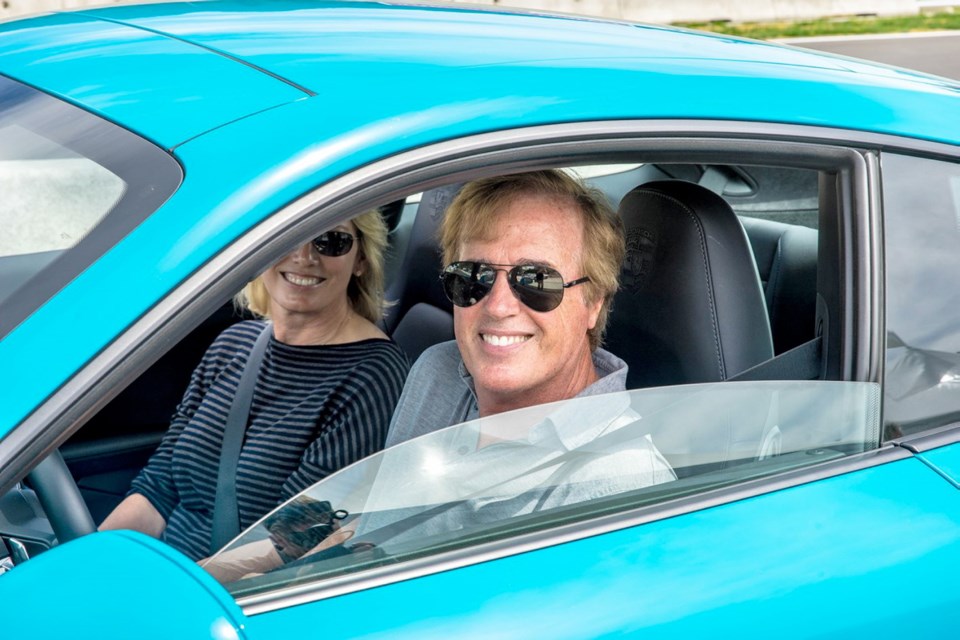‘I t was like a scene out a movie.” I must have heard that comment almost as many times as retired Formula One driver Danny Sullivan did hot laps at last week’s Vancouver Island Motorsport Circuit grand opening.
While GAIN Dealer Group’s exclusive motorsport country club in Cowichan isn’t a public raceway, the spectacular sight of cool, colourful cars prompted memories of auto-racing classics such as Grand Prix and Le Mans.
Sullivan, 66, can speak with authority about the differences between the real and reel worlds of auto racing.
It’s not just because of the Kentucky-born Indianapolis 500 champion’s impressive track record, notably his legendary “spin-and-win” Indy triumph in 1985, when he spun out before beating Mario Andretti.
The affable racer also has screen cred, including roles in The Doors, Love, Honour and Obey, Campus Man, Indianapolis 500 and an episode of Miami Vice, in which he played a Grand Prix driver accused of murder.
You could anticipate the Miami Vice quips before Sullivan found himself having fast and furious fun in a 2017 Porsche 911 Carrera. Its colour? Miami blue.
Ironically, if Sullivan’s famous Indy 500 spin-and-win scenario were pitched as a movie sequence, producers would likely have rejected it on the grounds it was too far-fetched.
While Sullivan said his intention was not “to be negative,” he questioned the authenticity of much of the action in Hollywood depictions such as Tony Scott’s 1990 blockbuster Days of Thunder.
“Parts of it were accurate,” the diplomatic racing legend allowed with a smile, recalling the lucrative Tom Cruise vehicle that critics complained had as much fakery as flash.
“These guys were characters beyond belief,” said Sullivan. He was referring to Tim Richmond, the model for Cole Trickle, Cruise’s cocky race-car driver determined to make a name for himself in NASCAR; Harry Hyde, whom Cole’s grizzled crew chief Harry Hogge, portrayed by Robert Duvall, was patterned on; and team owner Rick Hendrick, who inspired the colourful car dealership owner Tim Daland, played by Randy Quaid.
Sullivan said the characters were larger than life off screen, although the movie stretched credibility.
“Oh, yeah, big time, there was a lot of history there, but then Hollywood turned it into a movie,” he said, noting scenes in which characters ride around in the back of a truck didn’t ring true.
“They’d be in the back of a motorhome, not in the back of a truck.”
While his NASCAR competition was limited, Sullivan, who graced the cover of Playgirl with Catherine Bach during his years as a swaggering hotshot, said he enjoyed the film, nonetheless.
But he is less OK with the idea that race-car drivers aren’t real athletes.
“I’ve seen football players and baseball players go drive a car for five, six or seven laps, and I’m talking driving a [Toyota] Celica,” said Pebble Beach, California-based Sullivan. “They’re worn out.”
Drivers must be very fit to consistently put the pedal to the metal professionally in what is a physically demanding sport, he said.
“I also hear people say: ‘It’s a car! How hard can it be?’ ” Sullivan said, smiling. “But that’s like saying: ‘I play golf, and I’m going to break 100 at the PGA.’ ”
Last year’s press junket for Living in the Age of Airplanes, Brian Terwilliger’s aviation documentary showing at Imax Victoria, was “the coolest movie première ever” according to The Wrap’s Mikey Glazer.
Indeed, it was the ultimate example of “in-flight entertainment,” since the Imax film premièred on an Emirates A380 jetliner flying at 35,000 feet.
It was cruelly ironic that James Horner, the film’s composer (Titanic, Braveheart), died at age 61 in a plane crash.
“I’ve always been an airplane fanatic and I’ve always loved to fly, so it connected with me personally,” the Oscar-winner had said of the documentary shortly before his two-seater plane crashed near Santa Barbara, California, on June 22 last year.
Horner’s death triggered memories of something George P. Cosmatos, the late Victoria-based filmmaker of Rambo and Tombstone fame, once told me.
Cosmatos confided he would sometimes use Horner’s versatile passages from other films as “filler” on rough cuts before his own soundtracks were finalized, notably on Rambo.
Considering what a huge character Muhammad Ali was, it seems fitting that Ali, Michael Mann’s biopic, would return to a screen big enough to accommodate him (Monday, 7 p.m. at Cineplex Odeon).
The last time the late, great heavyweight boxing champion — who had Parkinson’s Disease diagnosed in the 1980s — appeared in Victoria was for the David Foster Foundation’s 25th anniversary charity fundraiser in 2012.
“Although his health had severely declined, it was still obvious he was a fighter,” recalled Foster, who was musical director of Ali’s Celebrity Fight Night Parkinson’s Disease fundraisers in Phoenix, Arizona, for 17 years.
Before his illness became too debilitating, Ali would get up onstage and play piano with Foster and do magic tricks.
“Every year, he made it. He’d get himself there and he wasn’t embarrassed about how he looked,” Foster said. “He wanted to give Parkinson’s a face.”
